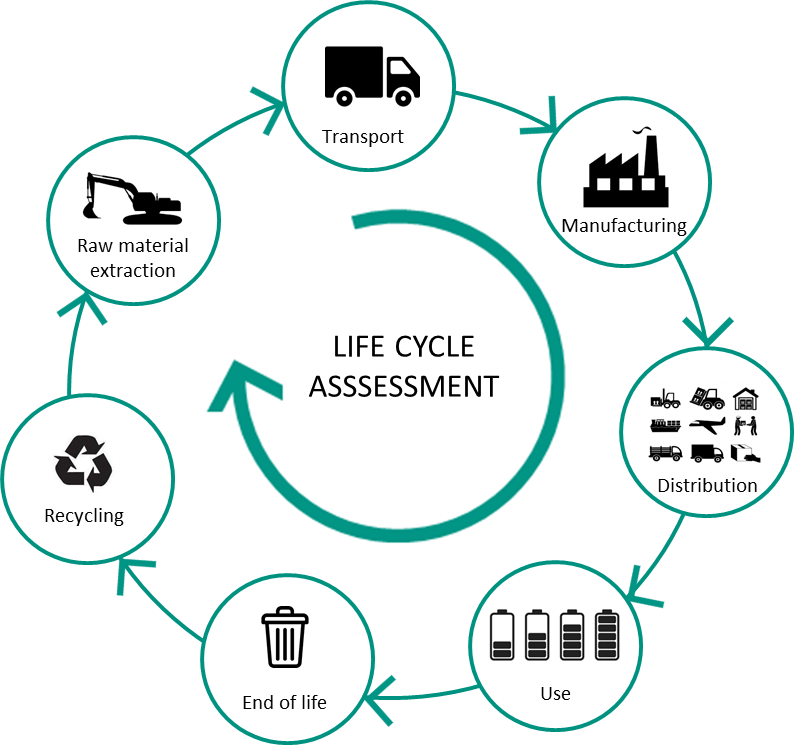LCA is a methodology that allows identifying, evaluating and quantifying in an iterative way, the environmental impacts of a product or process throughout its life cycle. In other words, from the procurement of raw materials for its manufacture to its end of life, including product´ s transport, manufacture and distribution.

The analysis of each of the stages allows us to identify, on the one hand, the resources used in the manufacturing process of the product, such as water, energy, renewable and non-renewable resources; and on the other hand, the environmental impacts generated in each of them. This analysis helps to obtain an exhaustive knowledge of the product´s or process´s environmental performance. The Carbon Footprint (CF) or Water Footprint (WF) are some of the results that can be obtained from a Life Cycle Assessment.
An LCA consists of four stages, as defined in the UNE-EN ISO 14040:2006 standard. Definition of the objective and scope; Life Cycle Inventory Analysis; Life Cycle Impact Assessment; and Life Cycle Interpretation.
The purpose of these stages is to establish the framework for the development of the study, define the quality of the data used, compile the data and, finally, evaluate and quantify the environmental impacts generated. It should be noted that in order to obtain reliable, extrapolable and comparable results, the information used in the analysis must be as complete and reliable as possible.
In this regard, the European Battery Platform, in its Strategic Research Agenda for batteries 2020, establishes that the tools and methodologies of environmental and social Life Cycle Assessment (LCA and S-LCA) that allow quantifying the sustainability performance of batteries must continue to be developed from a holistic perspective, establishing R&D actions that allow developing reliable data sources to guarantee transparency and allow comparing results between different types of batteries, as well as in other energy storage systems.
To achieve this, some of the guidelines defined by the Strategic Research Agenda for batteries 2020 in the short term (2020 - 2025) are: the development of battery eco-labels as a sustainability requirement; the use of LCA in the initial stages of design and the execution of LCA for new generation batteries, among others.
Therefore, it can be deduced that the greatest potential of the LCA is its application as a decision-making tool, implemented from the conception or design process of a product, since it allows the identification of those critical points that, from an environmental point of view, should be modified, improved or replaced, even before its manufacture. Moreover, working on different scenarios within the design process reduces costs and ensures compliance with environmental standards.
LCA results contribute, consequently, to identify opportunities for improvement, to provide relevant information in the strategic planning of products or processes, to establish priorities in the design and/or redesign and to the selection of environmental performance indicators, which results in competitive advantages at the industrial and business level.
Life Cycle Assessment has become one of the fundamental pillars of sustainable development, and has been consolidated through the different policies established by the European Union on environmental issues.
In 2003, the European Commission identified it as the "best framework for assessing the potential environmental impacts of products" and currently promotes its use as an integrated environmental assessment, essential in the EU policy-making process and the achievement of the objectives of, for example, the European Green Deal.
The European Green Deal includes, among its objectives, the promotion of energy storage solutions to achieve the goal of neutralizing CO2 emissions by 2050, which is why in recent years, the EU has proposed mandatory requirements for all batteries sold on the European market to be based on parameters such as: the use of materials of responsible origin with restricted use of hazardous substances; a minimum content of raw materials from recycled materials; calculation of the carbon footprint, performance, durability and labeling; and compliance with collection and recycling targets.
This means a requirement to produce batteries with a lower environmental impact, that are durable and safe, and that can be reused or recycled at the end of their useful life, so that valuable materials are reintroduced into the economy.
Taking into account the importance of LCA as a fundamental tool in the design and manufacture of energy storage systems, at CIC energiGUNE, we are committed to LCA as one of the essential pillars of our technological development in order to ensure compliance with sustainability standards in each of our developments.

Author: Andrea Casas, LCA analyst of CIC energiGUNE and Technical Advisor of the Batteries European Partnership Association (BEPA)

If you want to know the latest trends in energy storage and new developments in research, subscribe.

If you want to join a top-level team, collaborate with specialists in multiple disciplines or tell us about your concerns, don't think twice...